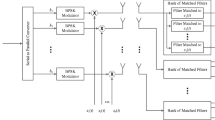Abstract
In this paper, a generalized multiple-input multiple-output (MIMO) antenna system that can be fitted to the uplink of a wireless communication system is considered for the general case of multi-user. At the transmitter, the information bits are Turbo coded, then interleaved and passed through a serial-to-parallel converter. The channel is assumed bad urban suffering from multipath Rayleigh fading resulting in inter-symbol and multiple access interferences (ISI and MAI). At the front-end of the receiver, a number of receiving antennas are used followed by a joint multi-user estimator based on the Minimum Mean Square Error Block Linear Equalizer (MMSE-BLE).
Computer simulations demonstrate a significant performance improvement in both single user and multi-user cases.
Similar content being viewed by others
References
G.J. Foschini, “Layered Space-Time Architecture for Wireless Communication in a Fading Environment When Using Multielement Antennas”, bell Labs Tech. J., pp. 41–59, Autumn 1996.
V. Tarokh, N. Seshardi, and A. Calderbank, “Space-Time Codes for High Data Rate Wireless Communication: Performance Criterion and Code Construction”, IEEE Trans. Inform. Theory, Vol. IT-44, pp. 744–765, March 1998.
S. Alamouti, “A Simple Transmit Diversity Technique for Wireless Communications”, IEEE J. Selected Areas Commun., Vol. SAC-16, pp. 1451–1458, Oct. 1998.
V. Tarokh, H. Jafarkhani, and A. Calderbank, “Space-Time Block Codes from Orthogonal Designs”, IEEE Trans. Inform. Theory, Vol. IT-45, pp. 1456–1467, July 1999.
G. Bauch, “Concatenation of Space-Time Block Codes and Turbo-TCM”, in Proc. IEEE ICC, pp. 1202–1206, June 1999.
H. Su and E. Geraniotis, “Space-Time Turbo Codes with Full Antenna Diversity”, IEEE Trans. Commun., Vol. COM-49, pp. 47–57, Jan. 2001.
A. Stefanov and T.M. Duman, “Turbo Coded Modulation for Systems with Transmit and Receiving Antenna Diversity Over Block Fading channels: System Model, Decoding Approaches and Practical Considerations”, IEEE J. Select. Area Commun., Vol. SAC-19, pp. 958–968, May 2001.
A. Stefanov and T.M. Duman, “Performance Bounds for Turbo-Coded Multiple Antenna Systems”, IEEE J. Select. Area Commun., Vol. SAC-21, pp. 374–381, April 2003.
A. Klein, “Multiuser Detection of CDMA Signals-Algorithms and Their Application to Cellular Mobile Radio”, Ph.D Dissertation VDI-Verlag, Dusseldorf, 1996.
A. Klein, G. Kaleh, and P. Baier, “Zero Forcing and Minimum Mean-Square-Error Equalization for Multiuser Detection in Code-Division Multiple-Access Channels”, IEEE Trans. Vehicular Technology, Vol. 45, pp. 276–287, May 1996.
P. Jung and J. Blanz, “Joint Detection with Coherent Receiver Antenna Diversity in CDMA Mobile Radio Systems”, IEEE Trans. Vehicular Technology, Vol. 44, pp. 76–87, Feb. 1995.
E.K. Al-Hussaini, H.M. Mourad, and A.S. Harmal, “Joint Detection and Diversity Techniques in CDMA Mobile Radio Systems”, Wireless Pers. Commun. J, Vol. 18, pp.129–147, 2001.
B. Lu and X. Wang, “Iterative Receivers for Multiuser Space-Time Coding Systems”, IEEE J. Select. Areas Commun., Vol. SAV-18, No. 11, pp. 2322–2335, Nov. 2000.
X. Wang and H.V. Poor, “Iterative (Turbo) Soft Interference Cancellation and Decoding for Coded CDMA”, IEEE Trans. Commun., Vol. COM-47, no. (7), pp. 1046–1061, July 1999.
J. Shen and A.G. Burr, “Iterative Multi-user-antenna Detector for MIMO CDMA Employing Space-Time Turbo Codes”, IEEE Global Telecommunications Conference, Vol. 1, pp. 419–423, Nov. 2002.
S. Benedetto and G. Montorsi, “Unveiling Turbo Codes: Some Results on Parallel Concatenated Coding Schemes”, IEEE Trans. Inform. Theory, Vol. IT-42, pp. 409–428, March 1996.
C. Berrou and A. Glavieux, “Near Optimum Error Correcting Coding and Decoding: Turbo-Codes”, IEEE Trans. Commun., Vol. COM-44, pp. 1261–1271, Oct. 1996.
L.R. Bahl, J. Cocke, F. Jelinek, and J. Raviv, “Optimal Decoding of Linear Codes for Minimizing Symbol Error Rate”, IEEE Trans. Inform. Theory, Vol. IT-20, pp. 248–287, March 1974.
A. Klein and P. Baier, “Linear Unbiased Data Estimation in Mobile Radio Systems Applying CDMA”, IEEE J. Selected Areas Commun., Vol. SAC-11, pp. 1058–1066, Sep. 1993.
Author information
Authors and Affiliations
Corresponding author
Additional information
This paper depends in parts on that presented at the 11th European Wireless Conference, Cyprus, Nicosia, pp. 187–192, April 2005.
Yasmine A. Fahmy was born in Guiza, Egypt, on June 4, 1976. She received the B.Sc., M.Sc. and Ph.D. degrees in Communication and Electronics engineering from Cairo University, Egypt on 1999, 2001 and 2005 respectively. She is presently an assistant professor at Cairo University, Egypt. Her current field of interest is wireless communication and channel estimation.
Hebat-Allah M. Mourad received her B.Sc., M. Sc. and Ph.D. degrees in electrical communication engineering from Cairo University, Egypt, in 1983, 1987 and 1994 respectively. Since 1983, she has been with the Department of Electronics and Communications, Faculty of Engineering, Cairo University, and is currently associate professor there. Her research interests include optical fiber communications, mobile and satellite communications.
Emad K. Al-Hussaini received his B.Sc degree in Electrical Communication Engineering from Ain-Shams University, Cairo, Egypt, in 1964 and his M.Sc and Ph.D. degrees from Cairo University, Giza, Egypt, in 1974 and 1977, respectively. From 1964 to 1970, he was with the General Egyptian Aeroorganization. Since 1970, he has been with the Department of Electronics and Communications, Faculty of Engineering, Cairo University, and is currently professor there. He was a research fellow at Imperial College, London, UK, and at the Moore School of Electrical Engineering, University of Pennsylvania, Philadelphia, PA, USA, in the academic years 1976/1977 and 1981/1982, respectively. In 1990, he received the Egyptian national encouragement award for outstanding engineering research. He has written several papers for technical international journals and conferences. His research interests include signal processing, fading channel communication, modulation, and cellular mobile radio systems. Dr Al-Hussaini is a senior member of IEEE. He is listed in Marquis Whos Who in the World and in the IBC (International Biographical Center, Cambridge) for outstanding people of the 20th century.
Rights and permissions
About this article
Cite this article
Fahmy, Y.A., Mourad, HA.M. & Al-Hussaini, E.K. Multi-User MIMO Mobile CDMA Uplink System Employing Turbo Coding and Joint Detection Through a Multipath Rayleigh Fading Channel. Wireless Pers Commun 38, 325–341 (2006). https://doi.org/10.1007/s11277-006-9017-x
Published:
Issue Date:
DOI: https://doi.org/10.1007/s11277-006-9017-x




